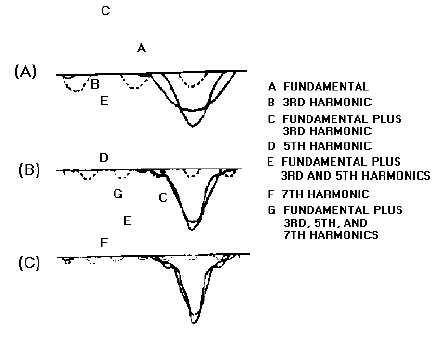4-35
reference line in phase with the fundamental. In the peaked wave, harmonics such as the third, seventh,
and so forth, cross the reference line 180 degrees out of phase with the fundamental; the fifth, ninth, and
so forth, cross the reference line in phase with the fundamental.
Figure 4-27.—Composition of a peaked wave.
Q15. What is the harmonic composition of a square wave?
Q16. What is the peaked wave composed of?
Q17. What is the fundamental difference between the phase relationship of the harmonics of the square
wave as compared to the harmonics of a peaked wave?
Nonsinusoidal Voltages Applied to an RC Circuit
The harmonic content of a square wave must be complete to produce a pure square wave. If the
harmonics of the square wave are not of the proper phase and amplitude relationships, the square wave
will not be pure. The term PURE, as applied to square waves, means that the waveform must be perfectly
square.
Figure 4-28 shows a pure square wave that is applied to a series-resistive circuit. If the values of the
two resistors are equal, the voltage developed across each resistor will be equal; that is, from one pure
square-wave input, two pure square waves of a lower amplitude will be produced. The value of the
resistors does not affect the phase or amplitude relationships of the harmonics contained within the square
waves. This is true because the same opposition is offered by the resistors to all the harmonics presented.
However, if the same square wave is applied to a series RC circuit, as shown in figure 4-29, the circuit
action is not the same.

